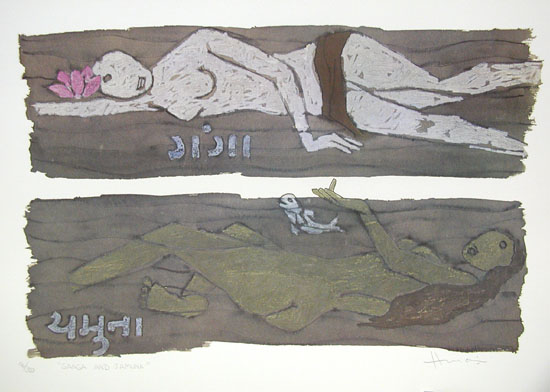
Archives
Contribute
| South Asian Art - In Memory Of Prashant H. Fadia |
Ranjani Saigal
11/13/2008
All four C words are used in any critic of artistic works. Is the classic presentation contemporary? Is it creative? Is the contemporary confounding? Does the contemporary need to leave tradition alone or embrace it? Does it have to be offensive to traditions to appeal? Is controversy important? Indian artists and audiences often puzzle over these.
Art in India has been an integral part of everyday life. Many southerners routinely begin their day with the drawing of the “Kolamâ€, which is a great artistic expression. The intricate sculptures in temples, the beautiful architecture of the mosques, brilliant paintings in the monastery are all testament to the centrality of art to the lives of Indians. Dance and music have had an important place in every ritual.
Traditionally art has been handed down from master to apprentice. The performer must use his/her performance or artist presentation as a vehicle to express the finest art - is a decree that has been amongst Indian artistic circles for generations. The art is considered more important than the artist and it has been held that a good artist will never use art for self-aggrandizement. This is often the reason why there is hardly any record of the names of artists who have created magnificent works of art. In the Ajanta caves the painting was a joint effort continuing over several generations of monks who felt that creating the art was their path to salvation. For the longest time there was continuity in the traditions and knowledge of tradition was valued and respected.
The 20th century heralded the arrival of the term “Contemporary". The influence of the colonial rule and with the advent of technological discoveries new artistic materials and tools afforded artists with the ability to experiment in new directions. Raja Ravi Verma used the techniques to honor and revere traditions by painting some of the most beautiful images from the Hindu traditions.
With the arrival of the term “Contemporary†and with a new found energy in the artistic traditions propelled by the new world, breaking with tradition became an important aspect of good art and a sign of genius. Picasso rocked the art world with his genius. As the western techniques and thoughts were being imparted in India with school of arts training artists in western traditions there was a new found energy amongst painters in India to break from traditional art and to present something new.
M.F Hussein was certainly a pioneer in the field of contemporary art and his artistic genius has been recognized in the western world. The Indian contemporary art scene has really grown since then with a large number of artists including Tyab Mehta, Jatin Das and others making a mark for themselves.
What makes for good Indian contemporary art? The standard answer you will know it when you see it. All artists draw from their traditions and Indian artists are no exception. Are the Indian traditions a handicap for contemporary artists or are they an asset? Do the traditions impede creativity for foster it? Traditions by their nature have sensitivities attached to them. Should artists respect those sensitivities? Some of M.F.Hussein’s works have certainly had their share of controversies. While some consider them as the invasion of the sacred others have applauded it as unfettered creativity.
The idea of the contemporary has also come to performing arts.
Chandralekha who was trained originally in Bharatanatyam, when she failed to find a foothold in that world broke with the tradition and moved into what she termed modern interpretations of Bharatanatyam. While one may argue about her motivation for creation of the work and even question her artistic abilities one cannot deny that she helped create a new path in Indian dance.
While for a long time the east and the west remained separate the emergence of a global Diaspora has slowly erased the walls between classic and contemporary in the Indian arts. The Diaspora values its Indian traditions, often has had intense training in the classical arts and understands the sensitivities attached with them while also having a through grounding and immersion in the western contemporary traditions. Brilliant dance works of Mythili Prakash, Lata Pada and the college students at different universities in the traditional art forms of Garbha, Bhangara and Bharatnatyam reflect this. Works of Anish Kapoor, Bose Krishnamachari and others have been taking center stage in the western art scene.
While there may be an odd artist here or there who feels that controversy and vulgar attacks on tradition is important to contemporary art the talented have found a comfortable space where the classic and contemporary can co-exist and what has emerged out of that – the new Indian contemporary art is not puzzling but beautiful. And yes !Be it classic or contemporary , you will know it when you see it! If you do not like it remember it is not your fault but poor art!
You may also access this article through our web-site http://www.lokvani.com/
